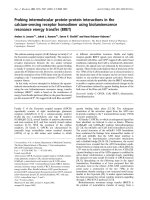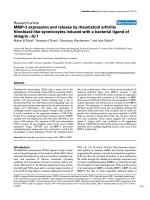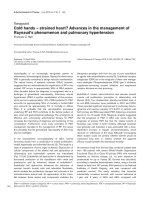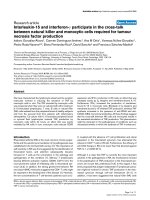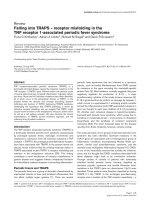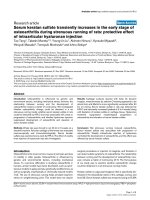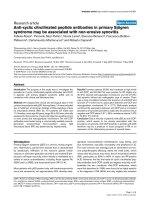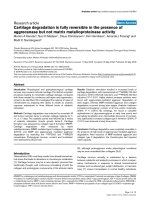Báo cáo y học: " Solitary Peutz-Jeghers type hamartomatous polyps in the duodenum are not always associated with a low risk of cancer: two case reports" pptx
Bạn đang xem bản rút gọn của tài liệu. Xem và tải ngay bản đầy đủ của tài liệu tại đây (1.45 MB, 4 trang )
CASE REPO R T Open Access
Solitary Peutz-Jeghers type hamartomatous
polyps in the duodenum are not always
associated with a low risk of cancer: two case
reports
Yusuke Sekino
1
, Masahiko Inamori
1*
, Mitsuru Hirai
2
, Kaori Suzuki
1
, Kaoru Tsuzawa
2
, Keiko Akimoto
2
,
Ayako Takahata
2
, Nobutaka Fujisawa
2
, Kumiko Saito
2
, Akisa Tsunemi
3
, Michio Tanaka
3
, Hiroshi Iida
1
,
Yasunari Sakamoto
1
, Hirokazu Takahashi
1
, Tomoko Koide
1
, Chikako Tokoro
1
, Yasunobu Abe
1
, Atsushi Nakajima
1
,
Shin Maeda
1
and Shigeru Koyama
2
Abstract
Introduction: A hamartomatous polyp without associated mucocutaneous pigmentation or a family history of
Peutz-Jeghers Syndrome is diagnosed as a solitary Peutz-Jeghers type hamartomatous polyp. As compared with
Peutz-Jeghers Syndrome, Peutz-Jeghers type hamartomatous polyps are diagnosed with a lower risk of cancer and
are regarded as a different disorder.
Case presentation: In case one, we describe an 84-year-old Japanese man with a 14 mm duodenal polyp.
Endoscopic mucosal resection was performed and histological examination showed findings suggestive of a
hamartomatous polyp with a focus of well-differentiated adenocarcinoma. In case two, we describe a 76-year-old
Japanese man who had been treated for prostate, rectal and lung cancer. Upper gastrointestinal endoscopy
revealed a duodenal polyp measuring 15 mm in diameter. Endoscopic mucosal resection was performed, and
histological examination showed findings suggestive of a hamartomatous polyp. Liver and thyroid cancers were
found after the endoscopic treatment.
Conclusion: Although duodenal solitary hamartomatous polyps are associated with a lower risk of cancer, four
patients, including our cases, have been diagnosed with cancerous polyps. Patients with duodenal solitary
hamartomatous polyps should be treated by endoscopic or surgical resection and need whole-body screening.
Introduction
Peutz-Jeghers Syndrome ( PJS) is a rare autosomal domi-
nant syndrome which is characterized by gastrointestinal
hamartomatous polyps and mucocutaneous pigmenta-
tion [1,2], first described by Peutz in 1921 [3].
A hamartomatous polyp without associated mucocuta-
neous pigmentation or a family history of PJS is diag-
nosed as a solitary Peutz-Jeghers type hamartomatous
polyp [4]. As compared with PJS, Peutz-Jeghers type
hamartomatous polyps are diagnosed with a lower risk
of cancer [5] and have been regarded as a different dis-
order from PJS.
We report two cases with a solitary Peutz-Jeghers type
hamartomatous polyp treated by endoscopic mucosal
resection.
Case Presentations
Case 1 is an 84-year-old Japanese man with previous
medical history of hypertension, chronic hepatitis C
infection, idiopathic thrombocytopenic purpura and
colon polyps (tubular adenoma and tubulovillous ade-
noma). He had no mucocutaneous pigmentation or
family history of PJS. An upper gastrointestinal endo-
scopy revealed a lobular polyp measuring 14 mm in
* Correspondence:
1
Gastroenterology Division, Yokohama City Universi ty School of Medicine, 3-
9 Fukuura Kanazawa-ku, Yokohama, 236-0004, Japan
Full list of author information is available at the end of the article
Sekino et al. Journal of Medical Case Reports 2011, 5:240
/>JOURNAL OF MEDICAL
CASE REPORTS
© 2011 Sekino et al; licensee BioMed Central Ltd. This is an Open Access article distributed unde r the terms of the Creative Commons
Attribution License (http://creativecom mons.org/licenses/by/2.0), which permits unrestricted use, distribution, and reproduction in
any medium , provided the original work is properly cited.
diameter, in the superior duodenal angle (Figure 1).
Endoscopic mucosal resection w as performed without
complication and histological examination showed find-
ings suggestive of a hamartomatous polyp–branching
bundles of smooth muscle fibers covered by hyperplastic
duodenal mucosa–with a focus of well-differentiated
adenocarcinoma (Figure 2). A colonoscopy and small-
intestinal follow-through showed no other polyps.
Case 2 is a 76-year-old Japanese man who had been
treated for prostate, rectal and lung cancer, with no
mucocutaneous pigmentation or family history of PJS.
An upper gastrointestinal endoscopy revealed a
duodenal polyp measuring 15 mm in diameter in the
second part of his duodenum (Figure 3). Endoscopic
mucosal resection was performed, and histological
examination showed findings suggestive of a hamarto-
matous polyp (Figure 4). A colonoscopy and small-
intestinal fol low-through showed no other polyps. After
the endoscopic treatment, concomitant liver and thyroid
cancers were found.
Discussion
As compared with PJS, Peutz-Jeghers type hamartoma-
tous polyps are diagnosed at a more advanced age, in
the absence of mutation of the STK11/LKB-1 gene, and
without familial history and mucocutaneous pigmenta-
tion [5].
Previous reports showed that polyps due to PJS had 3-
6% of neoplastic change, such as adenomas or carcino-
mas [4-18]. A search of case reports on the MEDLINE
database up to July 2010, using the terms “ha martoma-
tous polyp” and “duodenum”, and of reference lists of
published articles (including our cases), showed 27
patients with a solitary Peutz-Jeghers type hamartoma-
tous polyp in the duodenum (Table 1). Although solitary
Peutz-Jeghers type hamartomatous polyps have been
considered to show a lower potential for malignant
transformation as compared to PJS, three cases (includ-
ing ours) of solitary Peutz-Jeghers type hamartomatous
polyps with malignant components have been reported
since 2008, and the total malignant transformation rate
of solitary Peutz-Jehgher type hamartomatous polyps
was four out of 27 (14.8%). There were no significant
tendencies of malignant transformation within the age
Figure 1 A lobular duodenal polyp measuring 14 mm in
diameter was detected in the superior duodenal angle.
Figure 2 Histological examination showed findings suggestive
of a hamartoma: branching bundles of smooth muscle fibers
covered by hyperplastic duodenal mucosa, with a focus of
well-differentiated adenocarcinoma. Hematoxylin and eosin
staining (objective 10 ×).
Figure 3 Pedunculated duodenal polyp measuring 15 mm in
diameter in the second part of the duodenum.
Sekino et al. Journal of Medical Case Reports 2011, 5:240
/>Page 2 of 4
or sex of the patient, or the locati on, size or endoscopic
appearances of the polyp.
The most serious problem in PJS is an increased risk
of cance r in the gastrointestinal tract. The occurrence of
cancer in the gastrointestinal tract has been reported in
20-25% of patients with PJS, and a risk of cancer in
other organs has been also reported, including the
ovary, breast, bladder, pancreas and thyroid [2,19-22].
To the best of our knowledge, there have been no pre-
vious reports of patients with solitary Peutz-Jeghers type
hamartomatous polyps presenting with malignancy in
other organs. This is one of the reasons that solitary
Peutz-Jeghers type hamartomatous polyps have been
considered as a separate clinical entity from PJS. How-
ever, Case 2 in our report had duplicated malignancy in
six organs. An overlap between solitary Peutz-Jeghers
type hamartomatous polyps and PJS may need to be re-
examined.
Our two cases were diagnosed in patients with a n
advanced age simil ar to previous reports, but they differ
in the malignant alteration of a hamartomatous polyp
and concomitant other cancers. Patients with duodenal
Peutz-Jeghers type hamartomatous polyps should
undergo colonoscopy and whole-body screening; duode-
nal solitary Peutz-Jeghers type hamartomatous polyps
should preferably be treated by endoscopic or surgical
resection.
Conclusions
We report two cases of duodenal solitary Peutz-Jeghers
type hamartomatous polyp. Case 1 was a hamartoma-
tous polyp with a focus of well-differentiated adenocar-
cinoma, and Case 2 was a hamartomatous polyp with
Table 1 Twenty-seven cases of solitary duodenal Peutz-Jeghers type hamartomatous polyps.
Author Year Number of patients Age Sex Location Surface Size (mm) Treatment Malignant transformation
Gannon [6] 1962 6 NS NS NS Smooth NS NS No
Shiegel [7] 1978 1 75 NS 2nd Smooth NS surgery No
Ushijima [8] 1986 1 46 M 2nd Lobulated 20 × 20 × 15 endoscopy No
Bott [9] 1986 1 23 M 4th NS 50 × 40 surgery No
Naitoh [10] 1988 1 56 F 3rd Smooth 30 × 15 endoscopy No
Rossetti [11] 1989 1 22 F 2nd Smooth 50 endoscopy No
Tanaka [12] 1990 2 41 M 3rd Lobulated 25 × 18 endoscopy No
82 F 2nd Lobulated 25 × 20 endoscopy No
Nebri [4] 1993 1 63 F 1st NS 50 × 35 surgery No
Ichiyoshi [13] 1996 1 84 F 2nd Lobulated 25 × 20 endoscopy Yes
Oncel [14] 2003 2 68 F 3rd NS 15 endoscopy No
53 M 2nd Multiple polyps 5 endoscopy No
Kitaoka [5] 2004 1 22 F 1st Lobulated 35 × 30 × 30 endoscopy No
Itaba [15] 2006 2 87 F 2nd NS 17 endoscopy No
56 M 1st Lobulated 12 endoscopy No
Suzuki [16] 2008 3 59 F 2nd Lobulated 15 × 15 surgery No
68 F 2nd Lobulated 10 × 8 endoscopy Yes
60 F 1st Lobulated 10 × 10 endoscopy No
Jamaludin [17] 2009 1 46 M 1st Lobulated 70 × 40 surgery Yes
Kantarcioglu [18] 2009 1 28 M 2nd Lobulated 25 × 15 endoscopy No
Sekino: our report 2010 2 84 M 2nd Lobulated 16 × 13 endoscopy Yes
76 M 2nd Lobulated 15 endoscopy No
NS: not stated Ethnicity
Figure 4 Histological examination showed findings suggestive
of a hamartoma without malignant components. Hematoxylin
and eosin staining (objective 10 ×).
Sekino et al. Journal of Medical Case Reports 2011, 5:240
/>Page 3 of 4
five cancers in other organs. We advise that patients
with duodenal solitary Peutz-Jeghers type hamartoma-
tous polyps should preferably be treated with endscopic
or surgical resection and whole-body screening.
Consent
Written informed consent was obtained from both
patients for publication of these ca se reports and a ny
accompanying images. Copies of the written consent are
available for review by the Editor-in-Chief of this
journal.
Abbreviations
PJS: Peutz-Jeghers Syndrome.
Acknowledgements
No funding was required for this study.
Author details
1
Gastroenterology Division, Yokohama City Universi ty School of Medicine, 3-
9 Fukuura Kanazawa-ku, Yokohama, 236-0004, Japan.
2
Department of
Gastroenterology, Tokyo Metropolitan Hiroo Hospital, 2-34-10 Ebisu, Shibuya-
ku, Tokyo, 150-0013, Japan.
3
Department of Pathology, Tokyo Metropolitan
Hiroo Hospital, 2-34-10 Ebisu, Shibuya-ku, Tokyo, 150-0013, Japan.
Authors’ contributions
YS, MI, MH, KS, KT and KA analyzed and interpreted the patient data. AT, NF,
KS, AT, MT and HI analyzed endoscopic data. YS, HT, TK, CT, YA, AN and SM
performed the histological examination of the organs. YS, MI and SK were
major contributors in writing the manuscript. All authors read and approved
the final manuscript.
Competing interests
The authors declare that they have no competing interests.
Received: 11 November 2010 Accepted: 27 June 2011
Published: 27 June 2011
References
1. Jeghers H, Mckusick VA, Katz KH: Generalized intestinal polyposis and
melanin spots of the oral mucosa, lips and digits; a syndrome of
diagnostic significance. N Engl J Med 1949, 241(26):1031-1036.
2. Tomlinson IP, Houlston RS: Peutz-Jeghers syndrome. J Med Genet 1997,
34(12):1007-1011.
3. Peutz JLA: Very remarkable case of familial case of polyposis of mucous
membrane of intestinal tract and nasopharynx accompanied by peculiar
pigmentations of skin and mucous membrane. Ned Maandschr Geneeskd
1921, 10:134-146.
4. Acea Nebril B, Taboada Filgueira L, Parajó Calvo A, Gayoso García R, Gómez
Rodríguez D, Sánchez González F, Sogo Manzano C: Solitary
hamartomatous duodenal polyp; a different entity: report of a case and
review of the literature. Surg Today 1993, 23(12):1074-1077.
5. Kitaoka F, Shiogama T, Mizutani A, Tsurunaga Y, Fukui H, Higami Y,
Shimokawa I, Taguchi T, Kanematsu T: A solitary Peutz-Jeghers-type
hamartomatous polyp in the duodenum. A case report including results
of mutation analysis. Digestion 2004, 69(2):79-82.
6. Gannon P, Dahlin D, Bartholomew L, Beahrs O: Polypoid glandular tumors
of the small intestine. Surg Gynecol Obstet 1962, 114:666-672.
7. Siegel B, Yoran R: Duodenal hamartomas causing gastrointestinal
bleeding. Harefuah 1978, 95:75-76.
8. Ushijima S, Nakagawa M, Kim J, Kiyohara K, Segawa Y: Duodenal
hamartoma compatible with incomplete type Peutz-Jeghers syndrome:
Report of a case. Stomach Intest 1986, 21:1027-1030.
9. Bott S, Hanks J, Stone D: Solitary hamartomatous polyp of the duodenum
in the absence of familial polyposis. Am J Gastroenterol 1986, 81:993-994.
10. Naitoh H, Sumiyoshi Y, Kumashiro R, Inutsuka S, Fujita K, Yamamoto T,
Murayama H: A Solitary Peutz-Jeghers type hamartomatous polyp in the
duodenum. A case report. Jpn J Surg 1988, 18:475-477.
11. Rossetti G, Siringo G, Mantovani G, Musola R, Pregarz M, Volpe E, Marini E,
Marino F: Duodenal hamartoma: apropos of a case report. Radiol Med
1989, 77:134-136.
12. Tanaka H, Iida M, Kohrogi N, Matsui T, Yasunami Y, Yao T, Nakamura K,
Fujishma M: Endoscopic removal of solitary hamartomatous polyps of
the duodenum. Gastrointest Endosc 1990, 36:640-642.
13. Ichiyoshi Y, Yao T, Nagasaki S, Sugimachi K: Solitary Peutz-Jeghers type
polyp of the duodenum containing a focus of adenocarcinoma. Ital J
Gastroenterol 1996, 28:95-97.
14. Oncel M, Remzi FH, Church JM, Goldblum JR, Zutshi M, Fazio VW: Course
and follow-up of solitary Peutz-Jeghers polyps: a case series. Int J
Colorectal Dis 2003, 18:33-35.
15. Itaba S, Namoto M, Somada S, Nakamura K, Kumashiro Y, Nakamura N,
Yao T: Two cases of solitary Peutz-Jeghers-type hamartoma of the
duodenum. Endoscopy 2006, 38(Suppl 2):E32-E33.
16. Suzuki S, Hirasaki S, Ikeda F, Yumoto E, Yamane H, Matsubara M: Three
cases of Solitary Peutz-Jeghers-type hamartomatous polyp in the
duodenum. World J Gastroenterol 2008, 14:944-947.
17. Jamaludin AZ, Telisinghe PU, Yapp SK, Chong VH: Solitary duodenal
hamartomatous polyp with malignant transformation: report of a case.
Surg Today 2009, 39:527-532.
18. Kantarcioglu M, Kilciler G, Turan I, Ercin CN, Karslioglu Y, Guvenc I, Polat Z,
Bagci S: Solitary Peutz-Jeghers-type hamartomatous polyp as a cause of
recurrent acute pancreatitis. Endoscopy 2009, 41(Suppl 2):E117-E118.
19. Bartholomew LG, Moore CE, Dahlin DC, Waugh JM: Intestinal polyposis
associated with mucocutaneous pigmentation. Surg Gynecol Obstet 1962,
115:1-11.
20. Narita T, Eto T, Ito T: Peutz-Jeghers syndrome with adenomas and
adenocarcinomas in colonic polyps. Am J Surg Pathol 1987, 11:76-81.
21. Perzin KH, Bridge MF: Adenomatous and carcinomatous changes in
hamartomatous polyps of the small intestine (Peutz-Jeghers syndrome):
report of a case and review of the literature. Cancer 1982, 49:971-983.
22. Dodds WJ, Schulte WJ, Hensley GT, Hogan WJ: Peutz-Jeghers syndrome
and gastrointestinal malignancy. Am J Roentgenol Radium Ther Nucl Med
1972, 115:374-377.
doi:10.1186/1752-1947-5-240
Cite this article as: Sekino et al.: Solitary Peutz-Jeghers type
hamartomatous polyps in the duodenum are not always associated
with a low risk of cancer: two case reports. Journal of Medical Case
Reports 2011 5:240.
Submit your next manuscript to BioMed Central
and take full advantage of:
• Convenient online submission
• Thorough peer review
• No space constraints or color figure charges
• Immediate publication on acceptance
• Inclusion in PubMed, CAS, Scopus and Google Scholar
• Research which is freely available for redistribution
Submit your manuscript at
www.biomedcentral.com/submit
Sekino et al. Journal of Medical Case Reports 2011, 5:240
/>Page 4 of 4

